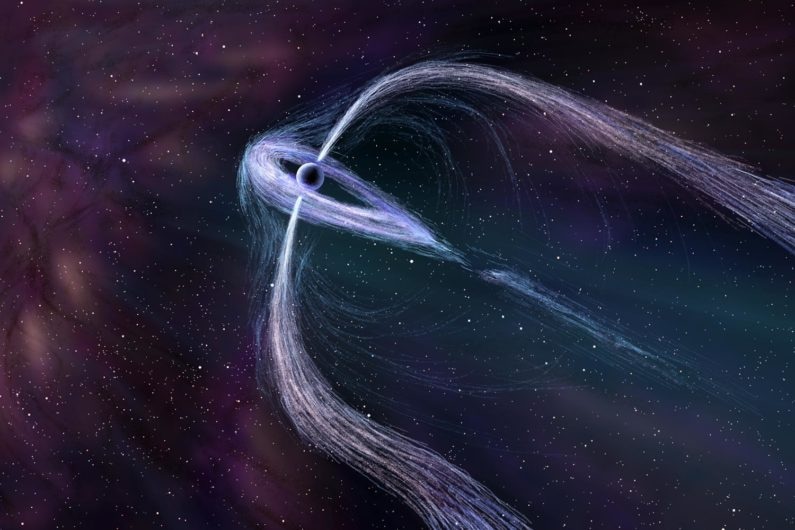Dec 8 2017
A recent study in Science cast doubt on one formerly favored explanation for why an abundance of positrons – the antimatter counterparts of electrons – has been found near Earth. Two nearby collapsed stars, it turns out, aren’t likely to blame because their positrons couldn’t have traveled as far as the Earth.
 Observations of the Geminga pulsar, shown in this illustration, made by the High-Altitude Water Cherenkov Observatory in Mexico indicate that it and another nearby pulsar are unlikely to be the origin of excess antimatter near Earth. (Image credit: Nahks TrEhnl)
Observations of the Geminga pulsar, shown in this illustration, made by the High-Altitude Water Cherenkov Observatory in Mexico indicate that it and another nearby pulsar are unlikely to be the origin of excess antimatter near Earth. (Image credit: Nahks TrEhnl)
This finding, which reopens a debate about a possible role for dark matter in creating those anomalous positrons, required piecing together complex data from the High Altitude Water Cherenkov Observatory (HAWC) in Mexico. HAWC, which looks like an array of giant, corrugated steel water tanks, can precisely reconstruct the direction and energy of incoming light – in the form of high-energy gamma-rays – by recording the particle shower that the gamma-ray photons generate when they enter the atmosphere above the detector.
In order to analyze that complex dataset, the HAWC collaboration turned to a software designed by Giacomo Vianello, a research scientist in the lab of Peter Michelson at Stanford University and a co-author of the study. The software, called the Multi-Mission Maximum Likelihood (3ML) framework, was originally designed to combine the data of the Fermi gamma-ray space telescope with the data from other instruments. Its ability to handle data in multiple formats and the unprecedented flexibility of its modeling tools allowed the HAWC team to question the pulsars’ role in generating the unexpected positrons.
“My collaborators and I spent many hours designing and developing 3ML for our research but also for other people to use,” Vianello said. “It is very exciting to see that some researchers find it so useful that they decide to use it for high-impact science like what HAWC published.”
Vianello and the rest of the 3ML team plan to continue improving the software. In addition to working across wavelengths and instruments, they hope it can be used with messengers other than light, such as polarization of electromagnetic radiation, cosmic rays and neutrinos.
The inspiration to create 3ML came from Vianello’s own work with the Fermi gamma-ray space telescope. Fermi has two main instruments, the Gamma-Ray Burst Monitor and the Large Area Telescope (LAT), which is led by Michelson, professor and chair of physics at Stanford. Even though these instruments exist on the same telescope, bringing their data together meant lengthy and cumbersome operations that often sacrificed some of the sensitivity of the LAT.
The situation worsens when the data come from completely different experiments and collaborations.
“It’s like completing a puzzle, where each instrument contributes a piece,” Michelson said. “However, the different pieces of the puzzle are very difficult and sometimes impossible to put together because they have different formats and require very different analysis methods and software.”
Scientists at Fermi have used 3ML for studying gamma-ray bursts. The project has also grown, now including 15 collaborators from the United States and Europe.
“Other missions and instruments have expressed the desire to join the effort and develop plug-ins for their data, so we’ve started working with them toward that,” Vianello said. “Some of them are even joining the development team, which is a very good thing because there is still a lot that can be done to improve 3ML.”
Michelson said he believes that, as it continues to improve, the software could be particularly useful for studying faint sources across multiple wavelengths. It could even play a vital role in solving the mystery of the excess antimatter.
“When completed, 3ML will, for the first time, allow for a powerful combination of Fermi, HAWC and other instruments for detailed analysis of extended sources, such as the one analyzed in the Science paper,” Michelson said.